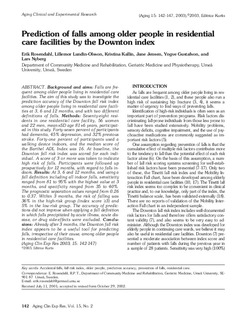| dc.contributor.author | Rosendahl, Erik | |
| dc.contributor.author | Lundin-Olsson, Lillemor | |
| dc.contributor.author | Kallin, Kristina | |
| dc.contributor.author | Jensen, Jane | |
| dc.contributor.author | Gustafson, Yngve | |
| dc.contributor.author | Nyberg, Lars | |
| dc.date.accessioned | 2017-06-07T12:40:05Z | |
| dc.date.available | 2017-06-07T12:40:05Z | |
| dc.date.issued | 2003 | |
| dc.identifier.citation | Rosendahl, E., Lundin-Olsson, L., Kallin, K., Jensen, J., Gustafson, Y. & Nyberg, L. (2003) Prediction of falls among older people in residential care facilities by the Downton index. Aging Clinical and Experimental Research, 15(2), s. 142-7. | |
| dc.identifier.uri | http://hdl.handle.net/11250/2445136 | |
| dc.description | Artikkelen rapporterer en studie hvor hensikten var å vurdere hvor godt instrumentet "Downtons fall risk index" kan predikere fall hos eldre bosatt i institusjon. | |
| dc.description.abstract | Background and aims: falls are frequent among older people living in residential care facilities. The aim of this study was to investigate the prediction accuracy of the Downton fall risk index among older people living in residential care facilities at 3, 6 and 12 months, and with two different definitions of falls. Methods: seventy-eight residents in one residential care facility, 56 women and 22 men, mean±SD age 81±6 years, participated in this study. 47% of participants had dementia, 45% depression, and 32% previous stroke. Forty-one percent of participants used a walking device indoors, and the median score of the Barthel ADL Index was 16. At baseline, the Downton fall risk index was scored for each individual. A score of 3 or more was taken to indicate high risk of falls. Participants were followed up prospectively for 12 months, with regard to falls indoors. Results: at 3, 6 and 12 months, and using a fall definition including all indoor falls, sensitivity ranged from 81 to 95% with the highest value at 3 months, and specificity ranged from 35 to 40%. The prognostic separation values ranged from 0.26 to 0.37. Within 3 months, the risk of falling was 36% in the high-risk group (index score ≥3) and 5% in the low-risk group. The accuracy of predictions did not improve when applying a fall definition in which falls precipitated by acute illness, acute disease, or drug side-effects were excluded. Conclusions: already after 3 months, the Downton fall risk index appears to be a useful tool for predicting falls, irrespective of their cause, among older people in residential care facilities. | |
| dc.language.iso | eng | |
| dc.subject | Sverige | |
| dc.title | Prediction of falls among older people in residential care facilities by the Downton index | |
| dc.type | Journal article | |
| dc.type | Peer reviewed | |
| dc.rights.holder | Rosendahl, Erik | |
| dc.source.volume | 15 | |
| dc.source.journal | Aging Clinical and Experimental Research | |
| dc.source.issue | 2 | |
| dc.identifier.doi | 10.1007/BF03324492 | |
